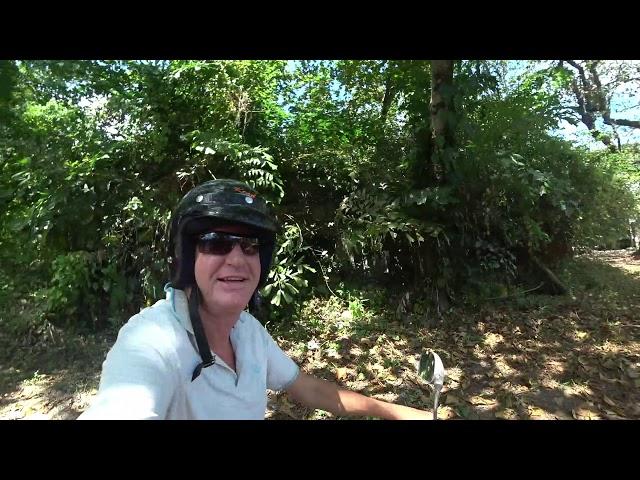
#Tanjung Bungah Beach #(Floating Mosque Side) #local monkey #local people #sun#sea#sand during MCO
Today's little 1 hr exercise under MCO, I'm a beach person, so what better way to hit the beach and a beach I've visited before and I got to see my mate again, the monkey, why they chained him up I don't know, maybe a spy? Friendly little fella but I think he was after my camera.
Great to talk to the locals and what a friendly bunch like all Penangnites I've encountered while being here for over a year.,
It's a must-visit ladies and gentlemen, it has everything, charm, friendly locals, great food, UNESCO heritage, grt beaches as you can see, weather and hardly rains during the day, cheap accommodation and cheap living and most of all, something for everyone! You won't be disappointed!!!
Tanjung Bungah (also spelt as Tanjong Bungah) is a suburb of George Town in Penang, Malaysia. It is located along the northern coast of Penang Island between Batu Ferringhi and Tanjung Tokong, and about 6.5 km (4.0 mi) northwest of the city centre.
Tanjung Bungah is well known as a beach destination, with several hotels and resorts lining the beaches within the area. Decades of urbanization has also led to the mushrooming of residential high-rises at Tanjung Bungah.
In addition, the suburb is home to a significant expatriate population; foreigners made up 5.7% of Tanjung Bungah's population as of 2010. A number of Royal Australian Air Force servicemen used to reside here while being stationed in Penang in the 1960s and 70s.
Due to its location along the northern coast of Penang Island, Tanjung Bungah was hard hit by the 2004 Indian Ocean tsunami.
Tanjung Bungah was formerly a quiet fishing village populated by Malay and Chinese fishermen. It only gained prominence as a beach destination of choice for locals and tourists in the 1950s. At the time, Batu Ferringhi had yet to be developed. The crystal clear waters off Tanjung Bungah also attracted two local swimming clubs into the area – the Penang Swimming Club and the Penang Chinese Swimming Club. Still prominent today are the clubs
The Royal Australian Air Force personnel who were stationed in Penang during the Malayan Emergency and the Indonesian Confrontation would escape to their residences at Tanjung Bungah, known as the Hillside. The spouses of the Australian servicemen also operated an amateur English language radio station – Radio RAAF – which could be tuned in throughout Penang and parts of neighboring Kedah.
Tanjung Bungah was one of the hardest-hit areas during the 2004 Indian Ocean tsunami that ultimately claimed a total of 52 lives in Penang. The Floating Mosque was subsequently built in 2005 and is now a major landmark at Tanjung Bungah.
The main thoroughfare within Tanjung Bungah is the coastal Tanjung Bungah Road, part of Federal Route 6. Tanjung Bungah Road continues on from Tanjung Tokong Road, cutting through the heart of the suburb until it becomes Batu Ferringhi Road near the western edge of Tanjung Bungah.
Alternatively, Vale of Tempe Road, stretching along the hills further inland, is used by motorists to exit Tanjung Bungah towards the neighbouring Tanjung Tokong suburb and on to George Town, and vice versa.These handful of road connections through the suburb are also prone to traffic congestion.
Rapid Penang buses 101, 102 and 104 serve the residents of the suburb, by connecting Tanjung
Great to talk to the locals and what a friendly bunch like all Penangnites I've encountered while being here for over a year.,
It's a must-visit ladies and gentlemen, it has everything, charm, friendly locals, great food, UNESCO heritage, grt beaches as you can see, weather and hardly rains during the day, cheap accommodation and cheap living and most of all, something for everyone! You won't be disappointed!!!
Tanjung Bungah (also spelt as Tanjong Bungah) is a suburb of George Town in Penang, Malaysia. It is located along the northern coast of Penang Island between Batu Ferringhi and Tanjung Tokong, and about 6.5 km (4.0 mi) northwest of the city centre.
Tanjung Bungah is well known as a beach destination, with several hotels and resorts lining the beaches within the area. Decades of urbanization has also led to the mushrooming of residential high-rises at Tanjung Bungah.
In addition, the suburb is home to a significant expatriate population; foreigners made up 5.7% of Tanjung Bungah's population as of 2010. A number of Royal Australian Air Force servicemen used to reside here while being stationed in Penang in the 1960s and 70s.
Due to its location along the northern coast of Penang Island, Tanjung Bungah was hard hit by the 2004 Indian Ocean tsunami.
Tanjung Bungah was formerly a quiet fishing village populated by Malay and Chinese fishermen. It only gained prominence as a beach destination of choice for locals and tourists in the 1950s. At the time, Batu Ferringhi had yet to be developed. The crystal clear waters off Tanjung Bungah also attracted two local swimming clubs into the area – the Penang Swimming Club and the Penang Chinese Swimming Club. Still prominent today are the clubs
The Royal Australian Air Force personnel who were stationed in Penang during the Malayan Emergency and the Indonesian Confrontation would escape to their residences at Tanjung Bungah, known as the Hillside. The spouses of the Australian servicemen also operated an amateur English language radio station – Radio RAAF – which could be tuned in throughout Penang and parts of neighboring Kedah.
Tanjung Bungah was one of the hardest-hit areas during the 2004 Indian Ocean tsunami that ultimately claimed a total of 52 lives in Penang. The Floating Mosque was subsequently built in 2005 and is now a major landmark at Tanjung Bungah.
The main thoroughfare within Tanjung Bungah is the coastal Tanjung Bungah Road, part of Federal Route 6. Tanjung Bungah Road continues on from Tanjung Tokong Road, cutting through the heart of the suburb until it becomes Batu Ferringhi Road near the western edge of Tanjung Bungah.
Alternatively, Vale of Tempe Road, stretching along the hills further inland, is used by motorists to exit Tanjung Bungah towards the neighbouring Tanjung Tokong suburb and on to George Town, and vice versa.These handful of road connections through the suburb are also prone to traffic congestion.
Rapid Penang buses 101, 102 and 104 serve the residents of the suburb, by connecting Tanjung
Тэги:
#Penang #travel #Malaysia #beachlife #beach #sea #sand #fishingboats #fishermen #penangbeach #tanjungbungah #tanjungbungahbeach #penanglifestyle #MCO #lockdownКомментарии:
Alan Jackson - Someday (Official Music Video)
alanjacksonVEVO
PERCY FAITH - 20 GOLDEN THEMES
Melodias Eternas de Siempre
Is your hair MEDIUM POROSITY? How To Tell
GreenBeauty










![Mellow & Sleazy, Focalistic [feat. Makhekhe] Wang Compromisa (Official Music Video) Mellow & Sleazy, Focalistic [feat. Makhekhe] Wang Compromisa (Official Music Video)](https://rtube.cc/img/upload/cy0xVHpLLUtoYzU.jpg)















